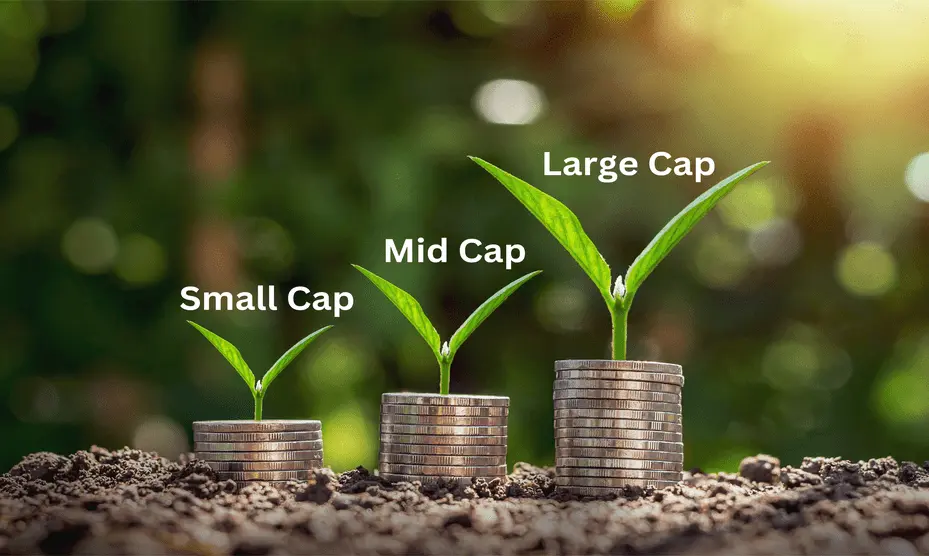
What are Small-Cap, Mid-Cap, and Large-Cap Stocks?
When investing in stocks, you will come across terms like mutual fund, small and mid-cap. Although they sound unusual, they are commonly used to speak about market capitalisation, a tool that helps guide your investment choices. While it does help to have done an online stock market training course, clear, in-depth knowledge is necessary.
To help you, we have written a comprehensive guide to investing in small-cap, mid-cap, or large-cap funds. We will start by covering a few mandatory basics and then see the differences that separate these three categories.
Understanding Large, Mid, & Small Market Capitalisation
Despite the title of this blog, you could still be asking, "What is small-cap, midcap and large-cap?" We don't blame you, and this blog would be difficult to read without understanding the meaning of market cap or capitalisation. It is the estimated value of a company based on bought shares.
Checking the company status is advisable to assess stocks before you invest. Higher market caps indicate many stocks already traded, while a low market cap shows fewer traded stocks. Looking at the stock market, you will see three categories exist:
- • Small-Cap Market Capitalisation.
- • Mid-Cap Market Capitalisation.
- • Large Market Capitalisation.
After a detailed look at market capitalisation, we will cover each one of the following: small-cap, mid-cap, and large-cap means and their characteristics.
What is a Large Cap Fund?
Every investor has probably heard about large-cap firms as they are renowned names. Through total market capitalisation, they are ranked 1 to 100. They are valuable assets to the country with a value of Rs.20000 or more!
Companies in this list of a hundred are established, strong, and have been expanding for decades.
Features of a Large-Cap Company
- • If investors want highly stable stocks with high liquidity levels, large-cap firms can provide them.
- • It is the point where large-cap, mid-cap, and small-cap firms differ the most. The extensive size of these established companies provides immense stability with little to no volatility.
- • These companies are famous for regularly providing dividend payouts to their shareholders.
- • Due to their size and dominance, these enterprises maintain top rankings in their industries.

What is a Mid Cap Fund?
This category is for companies with stability and proven capacity to grow. Although established, they aren't as pronounced on the market as larger enterprises.
Positions 101 to 250 are for Mid-cap companies. These firms in this group have a value no lower than Rs.5000 and no greater than Rs.20000 crores.
Features of a Mid-Cap Company
- • While a mid-cap company can grow, finding a highly profitable top mid-cap mutual fund is less likely.
- • These companies show exceptional stability and growth due to better market position. It reduces their volatility and makes them preferred over small caps.
- • Investors invest in these firms to diversify their portfolios and reduce investment risks.
What is a Small Cap Fund?
These companies are listed at position 251 and onwards according to total market capitalisation. The value of a small-cap company is never in excess of Rs.5000 crores.
Companies that fit in this category are early in their development phase. Although they are small-cap firms, they potentially can grow the most.
Features of a Small-Cap Company
- • Due to their size and market position, Investors seek small-cap stocks with huge growth potential due to immense profit opportunities.
- • Their smaller size means limited numbers of shares, resulting in liquidity problems as buyers struggle to find sellers.
- • Companies on a smaller scale get less coverage and attention from analysts and investors, leading to price issues.
- • While they offer great potential, any stock market mentor will warn you about their potential risks.

Small-Cap vs Mid-Cap vs Large-Cap
Upon hearing about these cap types, you would want a comprehensive comparison to understand better. To help you, we have a market cap comparison.
- • Company Traits
- • Volatility
- • Risk Magnitude
- • Profitability
- • Liquidity
- • Investor Suitability
Every large-cap firm is stable and operating well, and mid-caps are reliable and have potential, while small-cap companies are newly established and have high potential to grow.
Volatility increases from large caps to small caps. High volatility is a feature of small caps.
The least risky investment option is large caps, followed by mid-caps, and the risk-centric choice is small caps.
Small-cap, mid-cap, and large-cap companies all have returning capacity. The differences in these cap types are their magnitude and rate of return. A large-cap firm provides timely payouts, while mid-caps can give higher returns.
The stocks of a large-cap firm are the easiest to convert and liquidate. The stock from a small-cap firm is difficult to liquidate or sell.
Investors not looking for risks must look for large-cap options. However, anyone with mild risk tolerance can invest in mid-caps, while anyone seeking the highest risk and profit potential can invest in small caps.

Large Cap vs Small Cap vs Mid Cap: Which is Best to Invest in?
After looking at the qualities of each, you may wonder which stock suits your investment portfolio. See these guiding insights of which stock suits people with specific risk and profit requirements.
- 1. For Investors with a High-Risk Appetite
- 2. For the Invest Seeking a Balanced Approach
- 3. For Overly Cautious Investors
Individuals attracted to the possibility of massive profits, even if risky, should consider high-growth small-cap stocks. Such stocks would allow investors to benefit from rapidly emerging businesses.
Investors in this category are probably looking for equal growth and stability. Companies that sit in the mid-cap market capitalisation in India present a stable investment for slightly cautious investors.
Conservative investors are better off investing in large-cap stocks meaning, they don't have to worry about stability and low volatility. Another benefit of these enterprise companies is that they have high liquidity.
There is a significant difference between large-cap vs small-cap mutual funds investing. The separation factor of these three stocks is they appeal to different people.
Conclusion
These technical terms aren't complex when explained enough that anyone can understand! To recap:
- • Small-cap - These small firms have a high earning potential but high risks.
- • Mid-cap - A mid-cap establishment balances earning potential and risks.
- • Large-cap - Large-cap companies offer reliable earning potential and lower risks.
Do you understand these terms but still don't feel like you can make a confident investment? It's okay because you can contact us for a SEBI-certified research analyst who will pave the path to profitable investments in any cap!
FAQs on Small-Cap, Mid-Cap, and Large-Cap Stocks
-
Why are large-cap, mid-cap, and small-cap funds vital to my portfolio?
It takes a combination of these types of investments to protect against risk while maximising profit potential. A diverse portfolio with a mixture of small, mid, and large-cap funds is desirable. -
Is knowing small-cap, mid-cap, and large-cap differences essential for investing?
Anyone looking to make the best investments must have ample knowledge. It will require understanding these terms, which are common when discussing stock market investing. So, you must know what is a small cap fund or any other cap. -
Can I get help or assistance to invest in small or mid-cap companies?
Yes, there are experts on the market ready to share their ability to research and predict market movements. A research analyst researches particular industries and caps to guide your investing. Through their research, they can identify high-potential stocks and risky ones to avoid.


